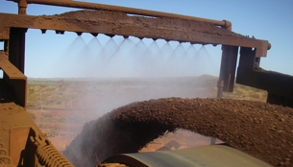
Reynolds Soil Technologies (RST Solutions) is assisting mine site operators to comply with tougher workplace exposure standards for airborne contaminants.
With spray and foaming systems being the most common methods for suppressing mineral dust, RST Solutions is advising companies along the material supply chain against boosting the dosage levels of surface active agents commonly used in these applications.
Typically, dust suppression methods involve a surface active agent added to water that is applied to the bulk material through spray or foaming systems to lift the dust extinction moisture levels.
While regular dust control formulas contain chemical elements considered low enough at application strength to not cause any problems, increasing the amount applied to meet strict dust exposure limits is not an acceptable solution, said David Handel, RST solutions operations and technical director.
“It is critical for dust control specialists using a spray or foaming suppression solution during mining, transportation and at storage facilities to understand the chemistry being used downstream to maintain product quality and prevent potential adverse chemical reaction during processing and manufacturing,” Handel said. “Dust control specialists need to look at how dust suppression additives can add value to improve downstream operation, not undermine end user processes by altering the product’s chemistry and devaluing quality.”
In response to issues raised by processing plants about some dust suppression agents affecting product quality, RST Solutions’ research and development team has been developing high-functioning formulas that preserve mineral properties for processing.
The chemistry is tailor-made to suit the mined material, various dust control application methods and downstream processes to provide a higher level of dust control efficiency along the whole material supply chain while remaining compatible with end-user expectations.
Without revealing the composition of RST Solutions’ technology, Handel said the company’s research and development team utilizes its combined industry knowledge of mineralogy, processing, manufacturing and chemistry to develop effective and cost-efficient surface-active agents and foaming dust suppressants.
“Surface active agents contain levels of sulfur, sodium and potassium, that if accelerated will alter a mineral’s chemistry and devalue quality, undermining end-user processes,” Handel said. “For example, elevated levels of these chemical elements reduces the quality of coal to the point it is considered lower grade coal unsuitable for steel manufacturing. There is a lot of pressure on companies that mine, transport and store coal to meet rigorous dust exposure standards, while continuing to supply high grade coal to steel manufacturers.
“While reducing dust levels is a high priority, it is critical for companies to make sure the dust control solutions they are using are compatible with the type of material being mined, the dust control application systems and the intended manufacturing processes,” Handel concluded.
RST Solutions, www.rstsolutions.com.au
